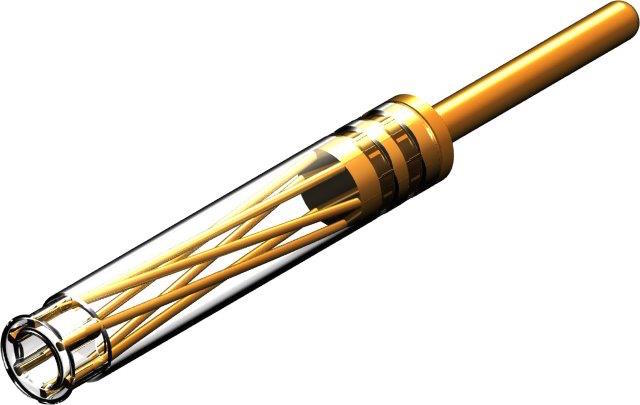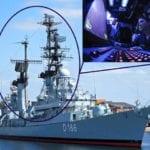Hyperboloid Contacts Improve High-Density Mil/Aero Rectangular Connectors
 Hyperboloid contacts improve contact density, mating force, functionality, and cycle-life in high-density rectangular connectors designed for mil/aero applications.
Hyperboloid contacts improve contact density, mating force, functionality, and cycle-life in high-density rectangular connectors designed for mil/aero applications.
Robert Lascelles, Product Manager – integraMate®, QA Technology Company, Inc.
Rectangular Connectors
In mil/aero applications, high-line-count rectangular connectors are often used as the interface between PCBs, between internal subassemblies, at input-output bulkheads, and between the equipment and outside.
Contact Density and Mating Force
MIL-DTL-55302 connectors are often used for board-level signal connections, and are offered in qualified parts list (QPL) and various commercial off-the-shelf (COTS) formats. The contacts in these connectors can be spaced as closely as 0.075” center-to-center, and can have line counts as high as 600. However, as the line count goes up, both the size and the amount of force required to mate these large-format connectors increases as well. MIL-DTL-55302 connectors have traditionally employed high-quality, gold-plated, screw-machined contacts, but high-pin-count versions have made use of hyperboloid contacts to reduce mating forces for many years now.
 Figure 1: QA Technology’s state-of-the-art integraMate® hyperboloid socket contacts provide lower insertion force, closer connector pin spacing, and better protection from damage than competitive designs.
Figure 1: QA Technology’s state-of-the-art integraMate® hyperboloid socket contacts provide lower insertion force, closer connector pin spacing, and better protection from damage than competitive designs.
Hyperboloid Contacts
Hyperboloid socket contacts, an alternative to conventional contacts, use a basket or nest of gold-plated, spring-contact wires to make contact with the mating pin at multiple locations. Hyperboloid contacts have a long history of use in demanding military/aerospace applications, in which their resistance to shock and vibration, low mating force, and high cycle-life have been well established. On the downside, traditional hyperboloid contacts have a reputation for being larger in diameter than more conventional screw-machined contacts, which presents a packaging problem in smaller, high-density connectors.
Micro-Format Rectangular Connectors
MIL-DTL-83513 Micro-D connnectors are widely used for bulkhead or panel applications in which space is at a premium. The Micro-D format uses compliant pin contacts that are either stamped or formed from twisted wires to mate with a simple tubular socket. The spacing between these contacts is 0.050”, and the resulting compact, self-polarized connector package is a familiar sight on the panels of mil/aero electronic systems. The downside of Micro-D contacts is that they can have engagement and separation forces as high as 6ozf (1.67N) apiece, meaning that a 51-line connector could require 85N for mating. As such, jack screws are essential and blind mating requires a method that can apply a lot of force.
 Figure 2: When used to replace conventional contacts in a 51-line Micro-D rectangular connector, QA Technology’s next-generation integraMate hyperboloid contacts reduce the total required mating force of from 85N to 15.6N while simultaneously improving connector performance and lifetime.
Figure 2: When used to replace conventional contacts in a 51-line Micro-D rectangular connector, QA Technology’s next-generation integraMate hyperboloid contacts reduce the total required mating force of from 85N to 15.6N while simultaneously improving connector performance and lifetime.
Solving the High-Force Micro-D Problem With Hyperboloid Contacts
A number of the panel-type applications that typically employ Micro-D connectors could be improved with the easy hand mating and tool-free latching that hyperboloid contacts enable. However, these contacts have traditionally been too large for use in micro format connectors. In response, one creative connector manufacturer recently developed a new generation of hyperboloid contacts that are 30% smaller in diameter, producing a center spacing that is exactly the same as traditional Micro-D contacts.
This new generation of hyperboloid contacts allows customers to exploit the contact technology’s low engagement and separation force to increase the number of mated lines while simultaneously improving both the functionality and, with rated lifetimes up to 100,000 cycles, even the cycle-life of a connector. Employed in a 51-position Micro-D connector, 2A-rated versions of these hyperboloid signal contacts only require a total of 3.5lbf (15.6N) for proper mating. In fact, the engagement/separation force of these next-generation hyperboloid contacts is so low — 32gf or 0.31N — they can also be considered for use as a low-force alternative to complicated zero insertion force (ZIF) connectors without requiring engineers to make any tradeoffs in shock and vibration performance or cycle life.





